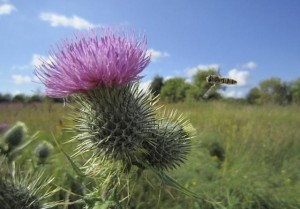How does global change affect trophic interactions between plants and pollinators?
Trophic interactions are complex
A basic principle of trophic interactions is that all species are affected by other species, in one way or another. Trophic interactions are complex and are therefore difficult to study. In high-school biology books, examples of trophic interactions are simplified, and often limited to two-trophic levels. For instance, hawk eats mice, or lynx eats hare. Many would be surprised that the abundance of fish in a mountain lake could affect the abundance of pollinators, that in turn affect plant crops. A decline in the abundance of fish in the lake could lead to more larval dragonfly, and dragonflies predate on pollinators.These multi-trophic interactions are clearly challenging to study. This is one example that illustrates why conserving biodiversity is important, and something everyone should be concerned with. Trophic interactions are so complex, and local extinction or decline in abundance of one species can have unknown consequences.
Global changes affect plant-pollinator interactions
Pollination is a mutualistic interaction in which both the pollinator and the plant benefit from the interaction. The pollinator ensures seed-dispersal for the plant, and the plant provides the pollinator with nectar. In other words, pollinators play an important role in ecosystem functions. In addition, pollinators are providers of ecosystem services important to humanity.
The decline in pollinator populations and species has been a hot topic. In my opinion this is largely because of convincing numbers that illustrate the great economical value of pollinators pollinating crops and providing food for humanity. The rapidly changing species distribution of pollinators is concerning. Current global changes impose several threats to pollinators, and there is no denying that human activity is largely to blame. Habitat change, invasive species and climate change have increased the risk of pollinator and plant species going extinct, locally or globally [1].
When speaking of global change in regards to ecology, one usually thinks of climate change. Climate change has been shown to affect phenological events, such as flowering in plants, and the first flight of pollinators [2].There is a tendency that pollinators start their activity earlier in the season than plants. This could cause a mismatch situation where pollinators start their activity before the plants are ready for them, and thereby limiting the opportunity for interaction between them [3].
Climate change may affect species directly, but also indirectly [2]. In addition, trophic partners can become disconnected because they may respond differently to global changes, such as climate change. The mismatch can be both spatial (distributional) and temporal (phenological) [2], however, there is much we do not know as the consequences of mismatches have not been thoroughly studied.

Hoverfly, a pollinator, aproaching a thistle head.
Photo: Lawrence Kirkendall
http://www.uib.no/en/rg/EECRG/55890/how-far-will-pollinator-go
Invasive species can disrupt existing plant-pollinator interactions
The introduction of new species can affect the trophic interactions. In fact, studies have shown that the presence of an invasive plant species can affect pollinators fidelity and preference to native plants [4]. This could affect the reproductive success of the native plant.It is difficult to predict the consequences. A case study indicated that pollinators will not necessarily prefer an invasive species that has a larger, showier floral display [4]. Another factor that must be taken into consideration is that the interactions can change over the course of an invasion.
Why should we bother?
First of all, biodiversity is in my opinion a good enough argument on its own. However, politicians are concerned with economics and numbers. Perhaps it is wise to focus on the arguments that will get their attention, and hopefully convince them to consider how their political decisions can affect biodiversity. Some might argue that focusing on ecosystem services rather than biodiversity being valuable in itself may lead to exploitation or ignoring conservation of species that are in danger of extinction, because they do not provide a significant ecosystem service. However, an important argument in my opinion is that we do not know enough about possible ecosystem services, therefore everyone should be interested in conserving biodiversity.
We may not be able to counteract global warming soon enough for the pollinators’ sake, but we can try to reduce the pressure on them. Habitat change has been declared as the greatest threat to biodiversity and the main reason why species go locally and globally extinct. Maybe this is where we should start.
References
2. Hegland, S. J., Nielsen, A., Lázaro, A., Bjerknes, A.-L. and Totland, Ø. (2009), How does climate warming affect plant-pollinator interactions?. Ecology Letters, 12: 184–195. doi: 10.1111/j.1461-0248.2008.01269.x
3. Memmott, J., Craze, P. G., Waser, N. M. and Price, M. V. (2007), Global warming and the disruption of plant–pollinator interactions. Ecology Letters, 10: 710–717. doi: 10.1111/j.1461-0248.2007.01061.x
4. King, V.M, Sargent, R.D., Presence of an invasive plant species alters pollinator visitation to a native, Accepted: 8 February 2012 Springer Science+Business Media B.V. 2012. Biol Invasions. doi: 10.1007/s10530-012-0191-3
interesting topic. But do you think we should restore habits in their original state (where possible) or that we should keep them as they are now?
That is a good question. I do not think that we have to choose between the two options. As with many things, it depends on the circumstances. In many cases I think it is easier to preserve original habitats, as opposed to restore them. Take fragmentation of habitats as an example. Restoring large areas might be difficult to accomplish. However, one option is to restore parts of the habitat, and make so called habitat-corridors that link isolated habitats.